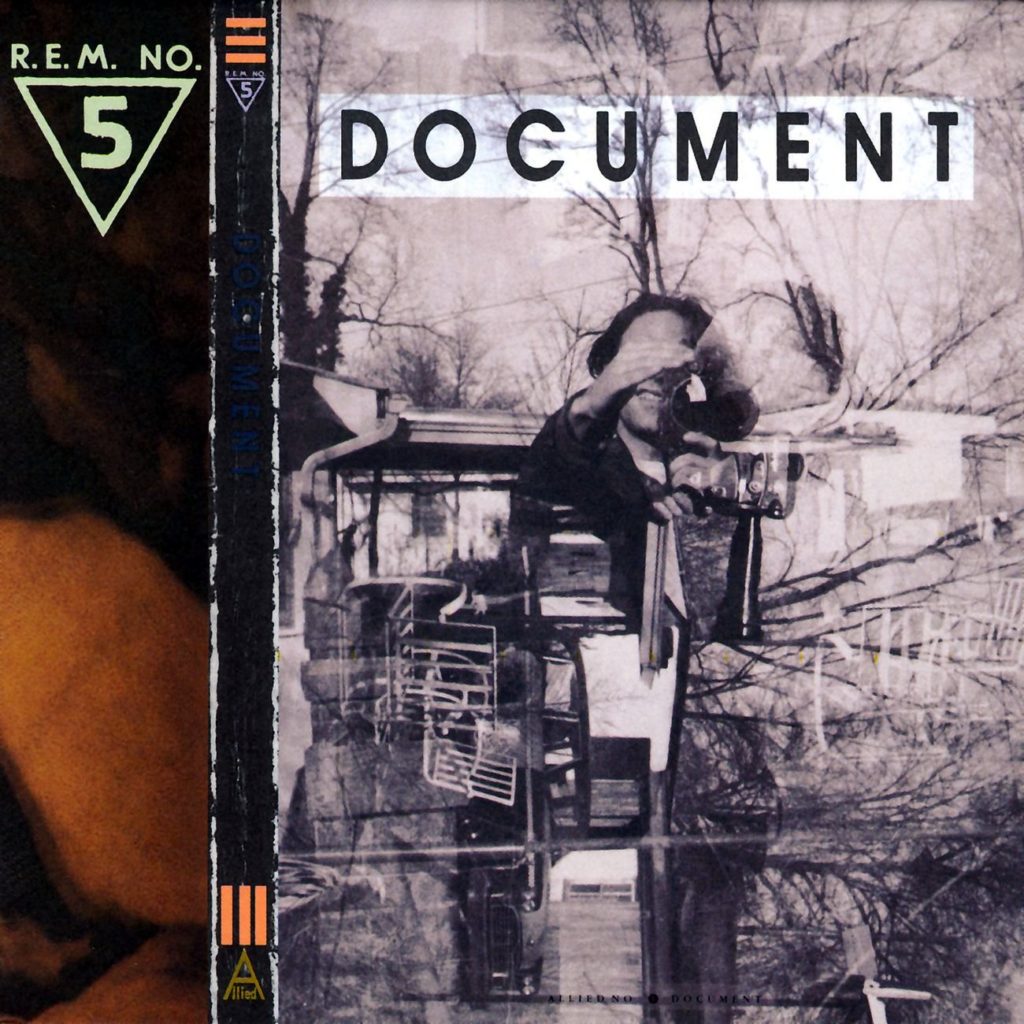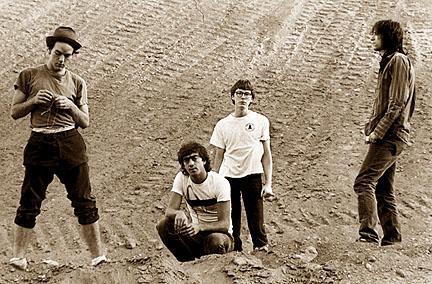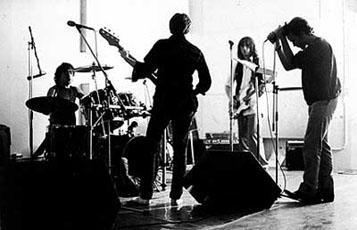R.E.M.’s ‘Document’: Not the End of the World, But the End of an Era
by Cary Baker R.E.M.’s Document, the Athens, Ga., quartet’s fifth studio release, was also their breakthrough album. Its first of three singles, “The One I Love,” reached #9 on the Billboard Hot 100, the beneficiary of I.R.S.’s long game of career development for the band, and aided by the promotional muscle of distributing label MCA Records.
R.E.M.’s Document, the Athens, Ga., quartet’s fifth studio release, was also their breakthrough album. Its first of three singles, “The One I Love,” reached #9 on the Billboard Hot 100, the beneficiary of I.R.S.’s long game of career development for the band, and aided by the promotional muscle of distributing label MCA Records.
Sadly, especially for employees of indie I.R.S. Records who had invested hearts, souls and long hours into R.E.M.’s build, it was also the band’s final effort for the label, before moving on to the greener and more global pastures of Warner Bros. Records.
But what a parting gift!
The album, released on August 31, 1987, was co-produced by the band and engineer Scott Litt, whose combined engineer, producer and remix credits include the dB’s (he produced their standout Repercussion), Nirvana (remixed “Heart Shaped Box” and “All Apologies”) and Patti Smith as well as producing some of R.E.M.’s initial Warner Bros. albums: Out of Time, Monster, Automatic for the People and New Adventures in Hi-Fi.
Document continued to capture R.E.M.s live energy on record, in the tradition of its two predecessors, Lifes Rich Pageant (1986) and Fables of the Reconstruction (1985). Michael Stipe’s vocals grew more assertive, and lyrics easy to make out (compared with the murmured phraseology of the band’s debut 1982 EP and 1983 LP), if not necessarily to decipher.
A listen in the 2020s also reveals at-the-time-unintended relevance to the state of the nation and world today. Consider, for instance, “Welcome to the Occupation,” which flows out of the lead track, “Finest Worksong,” reportedly about occupation in Central America:
Hang your collar up inside
Hang your freedom higher
Listen to the buyer still
Listen to the Congress
Where we propagate confusion
Next in the sequence is “Exhuming McCarthy”:
Enemy sighted, enemy met, I’m addressing the realpolitik
Look who bought the myth, by jingo, buy America
One might hear the song as a link between Sen. Joseph McCarthy, who accused many Americans of Communist leanings, and the posturing of the Ronald Reagan administration, under whose watch came the Iran-Contra affair. In either event, mention of “occupation” evokes nothing to a present-day ear so much as the infamous events of 34 years hence on January 6, 2021.
“Disturbance in the Heron House” was described by Stipe in 2009: “The song was my take on Animal Farm, an uprising dismissed by the powers that be.”
A stampede at the monument
To liberty and honor under the honor roll
The gathering of grunts and greens
Cogs and grunts and hirelings
The song strikes a commonality with R.E.M.’s prior work thanks to Peter Buck’s guitar jangling once again. It would have found a sonic home alongside, say, “Talk About the Passion” on Reckoning.
No stranger to an odd and unexpected cover song every now and again (the Clique’s “Superman” was one of the more whimsical moments on R.E.M.’’s Lifes RIch Pageant), Document includes “Strange,” a song by post-punk band Wire’s debut album, Pink Flag. Stipe refers to himself in the first line (“Michael’s nervous” replacing Wire’s line “Joey’s nervous”).
One of the standouts on Document—the song that seemed most relevant at the time, and ever since—was the side one closer, “It’s the End of the World as We Know It (And I Feel Fine).” Based loosely around a then-unreleased song called “Bad Day (PSA),” the song seemed inspired by Bob Dylan’s “Subterranean Homesick Blues,” with its own apocalyptic take. In the course of its mile-a-minute lyrics, the band references several historical notables with the initials “L.B.”: Leonard Bernstein, Leonid Brezhnev, Lenny Bruce and Lester Bangs.
The video by Georgia film- and video maker James Herbert gave the band the day off, its focus a teenage skateboarder who’s rummaging through remnants in his house after what appears to have been a tornado, including assorted R.E.M. artifacts and an I.R.S. Records logo statue. It may not depict life after a nuclear war, but to have one’s life upended by a destructive act of God would certainly seem the end of the world as one had come to know it.
Related: R.E.M. also spent part of 1987 helping out their friend Warren Zevon
As mentioned, R.E.M.’s hard-fought radio success came with Document’s lead single, “The One I Love.” On the surface, it seemed like a love song but, one I.R.S. employee called it a “seething love song” with its refrain “just another prop to occupy my time.” Stipe provided clarity: “It’s very clear that it’s about using people over and over again.”
The song is also known for its one-word chorus: “Fire.” Bassist Mike Mills sang in the background, “She’s coming down on her own now/Coming down on her own.” Buck received props for his guitar work. Portrait artist and photographer Robert Longo crested the video.

R.E.M. in the ’80s (l. to r.): Michael Stipe, Bill Berry, Mike Mills, Peter Buck (Photo from the band’s website)
No question the other songs on side two are lesser known than those on side one, although it contains some of the most ambitious if enigmatic song constructs of the band’s career.
The waltz-tempoed “Fireplace” found thematic connection with the topical songs of side one with its repeated lyrics of “crazy crazy world, crazy crazy times.” Los Lobos member Steve Berlin’s saxophone added a new hue to R.E.M.’s repertoire, his shadings reminiscent of John “The Rookie” Harden’s sax work on Iggy Pop and James Williamson’s Kill City.
Those expecting a tribute to the blues king of Houston’s Third Ward quickly find that side two’s “Lightnin’ Hopkins” is anything but an elegy—at least ostensibly—but rather a prayer: “When I lay myself to sleep, pray that I don’t go too deep.” Or perhaps it’s related to Stipe’s interest in film and video direction: “Shows the water, pan the track.” It is reportedly named for the bluesman as Buck had a Lightnin’ Hopkins LP with him in the studio that day.
Document has not one but two songs referencing birds, at least in the abstract. Side one’s “Disturbance at the Heron House” is bookended by side two’s “King of Birds.” It has been interpreted as the natural instinct of birds to sense earthquakes and other natural disasters. Conversely, the song, which features dulcimer by Buck, might have addressed Stipe’s reluctant but by now indelible rock stardom:
Standing on the shoulders of giants leaves me cold
A mean idea to call my own, a hundred million birds fly away
The album closes with one of its deepest tracks, a rocker titled “Oddfellows Local 151.” The song is not literally about the Oddfellows—a social organization not unlike the Moose or Elks—but, as Buck revealed in an interview, rather a group of homeless individuals living not far from Stipe, whom the lead singer likened to such an organization:
Oddfellows local 151 behind the firehouse
Where Peewee sits to prove a sage to teach
Peewee gathered up his proof
Reached up and scratched his head
Fell down and hit the ground again
Document was the work of a band spreading its aural and lyrical wings, at once more understandable word-for-word, while in spots as opaque as Chronic Town. Only R.E.M. could give us an ostensible love song that’s really a funeral for a relationship. Or a song about “Lightnin’’ Hopkins” devoid of blues reference points.
But to listen to it today is to glean a wholly unintended new meaning.
By this time, R.E.M. was filling amphitheaters and sheds, and there was no holding them back. Their saga, from Athens bar band to Hollywood Bowl headliners in six short years, became the music industry’s template for Artist Development 101.
“We never made giant steps to make ourselves a viable, hit-making American band for American radio,” Stipe reflected on In the Studio With Redbeard. “Radio came to us…pop culture just swung into our little, stubborn trajectory.”
R.E.M.’s recordings are available in the U.S. here and in the U.K. here.
Bonus Video: Watch R.E.M. perform “The One I Love” live







3 Comments so far
Jump into a conversationLove REM! I always found it interesting how not just the college-rock crowd, but also straight-up Goths I knew back in the late 80’s/early 90’s loved these guys. A testament to a great (and somewhat mysterious) band. I still wear their shirts and play them frequently.
Great live band. Saw the “Monster” tour, what a show. The only band that ended that never started again. They remain retired.
Nice article. Cary, I remember reading your stuff years ago when I was in school at NIU in DeKalb. I’m still in DeKalb but glad to see you’ve had a successful career.